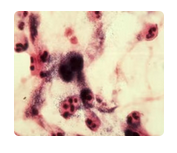The combination of complement C4, C2 and C3 that binds to the antigen-antibody complex in the initial reaction step in the classical pathway of complement activation is called the activation unit. Which of the following is the "activation unit" in the classical complement pathway?
A. C1
B. C2
C. C4, C2, C3
D. C5, C6, C7, C8, C9
E. C1, C2, C9
Certain recipients have increased risk for developing TA-GVHD. They are:
Neonates less than 4 months of age
Fetuses
Recipients with a congenital or acquired immunodeficiency, such as bone marrow or stem
cell recipients, and patients receiving chemotherapy
recipients of donor units from a blood relative.
Which of the following patients are at risk for transfusion-associated graft versus host
disease (TA-GVHD) and require irradiated cellular blood products? (Choose all that apply)
A. Neonates less than 4 months of age
B. Recipients of donor units known to be from a blood relative.
C. Patients with chronic anemias.
D. Patient receiving chemotherapy who are immunocompromised.
E. Patients with a history of allergic reactions
This Gram stain is under-decolorized.
This microscopic field is representative of other fields that were observed on a Gramstained
smear. Which of the following describes the quality of the smear?

A. Under-decolorized
B. Over-decolorized
C. Sufficiently decolorized
21 CFR 606.65 states, "Supplies and reagents shall be used in a manner consistent with
instructions provided by the manufacturer."
The correct answer is A. The reagents must be used according to the manufacturer's
instructions for use. If the instructions say one or two drops may be used and the facility
procedures also allow one or two drops, then there is no problem with the staff members
choosing to use two drops.
While equipment must be calibrated, it does not generally influence the number of drops
used.
Staff members often ask co-workers and colleagues from other facilities how to perform
tasks, but it is the manufacturer's instructions for the operation of equipment and the use of
reagents that must be followed.
A laboratory employee who is performing an internal audit of routine ABO and Rh typing
procedures notes that a technologist places two drops of Anti-D in a tube, centrifuges the
tube for 20 seconds, and reads the reaction using a magnifying mirror. When questioned
about the procedure, the technologist indicates that most staff use two drops of Anti-D
reagent because the reactions are stronger with two drops. In addition to reviewing the
facility procedure manual, what should be done to ensure regulatory compliance?
A. Review the anti-D manufacturer's current instructions for use.
B. Check the calibration records for the centrifuge.
C. Call a colleague at another institution to ask what they do.
A key laboratory characteristic by which Mycobacterium bovis can be separated from Mycobacterium tuberculosis is:
A. Niacin accumulation when grown on egg based medium
B. Ability to take up iron salts from the culture medium
C. Growth inhibition by thiopine-2-carboxylic acid hydrazide (T2H)
D. Semiquantitative catalase
In primary responses, the major class of antibody produced is IgM whereas in the secondary response, as mentioned in this question, it is IgG. IgG is present in the highest quantities compared to all other antibody classes and is the only antibody able to cross the placental barrier. Which of the following antibody types is chiefly seen in the secondary immune response:
A. IgG
B. IgA
C. IgM
D. IgD
An international, nonprofit organization that establishes standards of best current practice for clinical laboratories is
A. Centers for Disease Control and Prevention (CDC)
B. Commission on Office Laboratory Accreditation (COLA)
C. Clinical Laboratory Standards Institute (CLSI)
D. the Joint Commission
A patient has a WBC count of 4,000/mm3, a platelet estimation with 3 bizarre platelets/oil immersion field, hemoglobin, hematocrit, red cell count and indice values are within normal limits. Blue-staining inclusions are seen in the cytoplasm of many neutrophils. These inclusions fit the description of:
A. Auer rods
B. Barr bodies
C. Dohle bodies
D. May-Hegglin bodies
Interferon gamma serves various purposes in immunologic response, including the promotion of natural killer cell activity as well as decreased viral replication by using enzymes to decrease protein replication, both viral or host, inside of the cell. The lymphokine most important for increased natural killer cell activity and decreased viral replication in cells is:
A. Interferon gamma
B. Interleukin 3
C. Interleukin 4
D. Interleukin 5
Ammonium biurate crystalsare typically round, irregularly spiked and yellow-brown in color. A microscopic examination of a normal urine pH 8.0 shows 2+ yellow-brown thorny spheres which are MOST probably:
A. ammonium biurate crystals
B. ampicillin crystals
C. amorphous urate crystals
D. crenated red cells
E. waxy casts
Which area of the laboratory is responsible for blood coagulation studies that test for the patient's ability to clot their blood?
A. Blood banking/transfusion medicine
B. Immunology
C. Clinical chemistry
D. Hematology
The body of a tapeworm is composed of successive segments known as proglottids. Each mature proglottid has both male and female reproductive structures. What is the anatomical feature of a tapeworm that possesses both male and female reproductive structures?
A. Brood capsule
B. Proglottid
C. Rostellum
D. Scolex
| Page 4 out of 47 Pages |
| Previous |